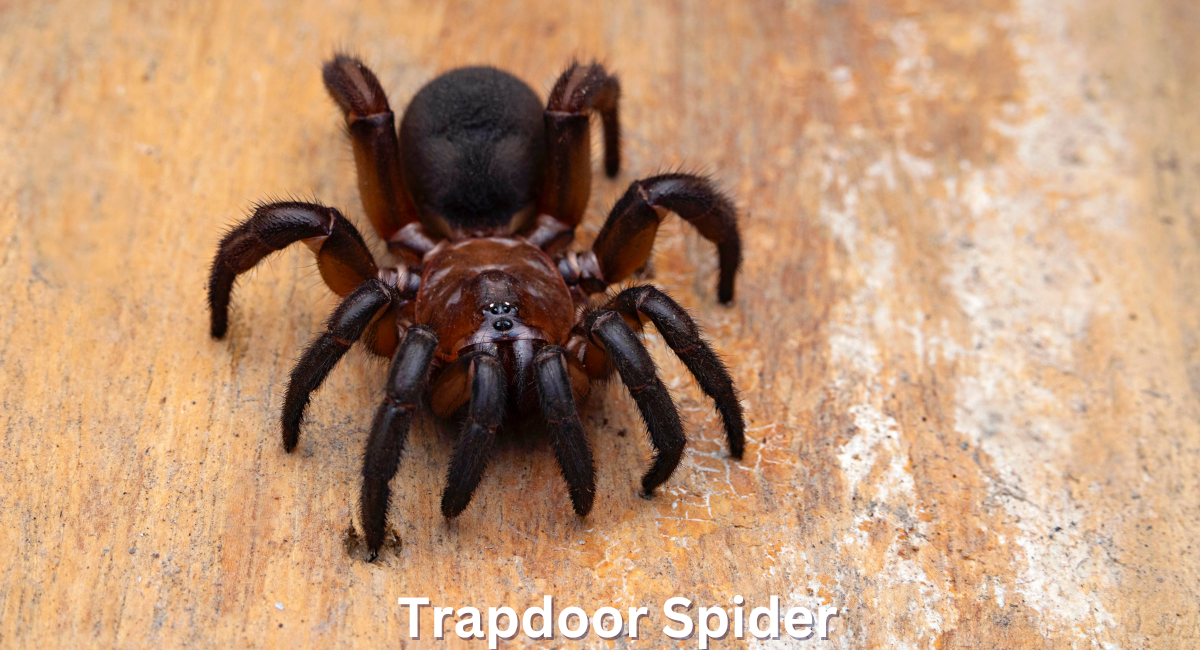Trapdoor Spider are an intriguing group of arachnids that have captured the interest of both researchers and nature enthusiasts alike. Belonging to the family Antrodiaetidae and the subfamily Atypoidinae, trapdoor spiders are known for their unique hunting strategies. They also have distinctive burrow-building behavior. These spiders construct silk-lined burrows with a camouflaged trapdoor. This allows them to ambush unsuspecting prey. This remarkable adaptation aids in hunting and provides protection from predators.
The morphology of trapdoor spiders varies significantly among species. Some exhibit striking coloration and size variations. These differences help them survive in diverse habitats. Trapdoor spiders primarily inhabit loose, sandy soils in grasslands, forests, and scrublands. Their burrows serve as both homes and hunting grounds. These spiders contribute to pest control by preying on various insects. This plays a vital role in maintaining ecosystem balance.
Their unique adaptations make them subjects of interest in scientific research. They provide insights into evolutionary biology and arachnid behavior. Understanding their behaviors and ecological importance helps in conserving their habitats. It also supports the conservation of species that rely on them.
Physical Characteristics of Trapdoor Spiders
Trapdoor spiders exhibit a range of physical characteristics that make them stand out in the arachnid world, though they are not typically classified among the deadliest spiders in the world. Typically, these spiders are medium to large in size, with a body length ranging from 1 to 5 inches. Their coloration varies, often featuring earthy tones like browns and grays, which help them blend seamlessly into their surroundings. This cryptic coloration is vital for their survival, allowing them to remain hidden from predators and prey alike. While trapdoor spiders possess venom that can subdue their prey, it is not lethal to humans, distinguishing them from some of the more dangerous members of the arachnid family.
One of the most striking features of trapdoor spiders is their robust, hairy bodies and powerful jaws. They possess strong fangs capable of delivering a venomous bite. This bite is primarily used to subdue prey, not for defense against larger threats. Unlike many other spider species, trapdoor spiders have a distinctive flattened appearance. This unique feature aids in their burrowing lifestyle. Their legs are well-adapted for digging and navigating subterranean environments. These adaptations enhance their survival and hunting success.
Habitat and Distribution
Trapdoor spiders are fascinating arachnids that inhabit various ecosystems around the globe, primarily in temperate and tropical regions. They prefer environments with loose, sandy soil, such as grasslands, forests, and scrublands, which provide ideal conditions for constructing their distinctive burrows. These burrows are often lined with silk and debris, creating a camouflaged entrance resembling a trapdoor, a crucial adaptation for both hunting and protection. Just as trapdoor spiders have evolved specialized behaviors for survival, many of the deadliest snakes in the world have developed potent venom and unique hunting techniques that make them formidable predators in their respective environments.
In the United States, you can most commonly find trapdoor spiders in the western states, particularly in California, Arizona, and Nevada. However, these spiders also inhabit other parts of the world, including Australia, Africa, and parts of Asia. The diverse range of habitats in which trapdoor spiders thrive demonstrates their adaptability and resilience in various environmental conditions. Similarly, reptiles such as the inland taipan and the black mamba adapt well to various terrains, from arid deserts to lush forests, showcasing the incredible diversity of predatory adaptations among reptiles and arachnids alike.
Burrow Construction
The construction of burrows is one of the most fascinating aspects of trapdoor spider behavior, including the intriguing interaction with other spider species like the Yellow Sac Spider. These spiders create silk-lined tunnels, often several inches deep, that serve as both a home and a hunting ground. The entrance to the burrow is typically covered with a camouflaged trapdoor made of silk, soil, and debris, which helps the spider remain hidden from potential threats. This construction technique not only provides shelter but also helps trapdoor spiders evade predators, including the which is known for its aggressive hunting tactics.
The trapdoor is not just a protective barrier; it also plays a crucial role in their hunting strategy. Trapdoor spiders lie in wait for unsuspecting prey, including various insects and even other spiders like the , to pass by, ready to ambush them as they approach the burrow entrance. This method of hunting is particularly effective, allowing trapdoor spiders to catch a variety of insects, such as crickets, beetles, and other small arthropods. By utilizing their expertly crafted burrows and keen senses, trapdoor spiders efficiently capture prey, highlighting the dynamic interactions among spider species in their shared ecosystems.
Hunting Behavior
Trapdoor spiders, including the fascinating , are primarily nocturnal hunters that employ a unique strategy to capture their prey. Once they detect vibrations from an unsuspecting insect near their burrow, they spring into action with remarkable agility. Using their powerful legs, they swiftly open the trapdoor and pounce on their prey with incredible speed and precision. This hunting technique allows them to remain concealed until the opportune moment arises, making them effective predators in their natural habitats.
The hunting method of trapdoor spiders, such as the Chinese Bird Spider, is a testament to their evolutionary adaptations. They rely heavily on their keen sense of touch and vibration detection to identify the presence of potential meals. This remarkable ability not only conserves energy but also significantly increases their chances of a successful hunt, allowing these spiders to thrive in their environments. The combination of their unique burrowing behavior and effective predation strategies underscores the adaptability of trapdoor spiders within their ecosystems.
Reproduction and Lifespan
Reproduction in trapdoor spiders is a fascinating process. It involves intricate courtship rituals, similar to those seen in other spider species. Male trapdoor spiders often perform elaborate displays to attract females. These displays may include tapping on the burrow or producing vibrations. After a successful courtship, females lay their eggs in a silk-lined sac within the burrow. They carefully guard the sac until the spiderlings emerge. This nurturing behavior highlights the commitment of trapdoor spiders to their offspring. It is vital for ensuring the continuation of their lineage.
The lifespan of trapdoor spiders can vary significantly, with some species living for several years, similar to the longevity observed in the Brazilian Wandering Spider. Females typically have longer lifespans than males, often living up to 20 years or more in favorable conditions. This longevity is particularly beneficial for females, as it allows them to produce multiple egg sacs throughout their lives, thereby increasing their reproductive success. The adaptability and resilience of trapdoor spiders in various environments demonstrate their evolutionary advantages, just as the has developed unique survival strategies in its habitat.
Ecological Role and Importance
Trapdoor spiders, while not among the deadliest spiders in the world, play a crucial role in their ecosystems as both predators and prey. As predators, they help control insect populations, maintaining a balance within their habitats. By feeding on various insects, trapdoor spiders contribute to the overall health of the ecosystem, preventing the overpopulation of certain species that could disrupt ecological harmony. Their unique hunting techniques and burrowing behavior also highlight the diverse adaptations found within the arachnid family.
Additionally, trapdoor spiders serve as a food source for a variety of predators, including birds, reptiles, and other larger spiders. This relationship positions them within the broader context of food webs, emphasizing their importance in maintaining the delicate balance of ecosystems. While they are not among the most feared their role in the environment underscores the interconnectedness of life and the necessity of preserving their habitats to ensure biodiversity thrives.
Conservation Status
While many species of trapdoor spiders are not currently endangered, habitat destruction and climate change pose significant threats. These factors affect their populations, including well-known species like the Sydney Funnel Spider in Australia. Urban development, agricultural expansion, and deforestation lead to the loss of suitable habitats. This makes it increasingly difficult for trapdoor spiders and the Sydney Funnel Spider to survive and thrive. These environmental changes disrupt their natural ecosystems. They also increase the spiders’ vulnerability to predation and competition for resources.
Conservation efforts are essential for preserving natural habitats and promoting biodiversity. This is crucial for the survival of trapdoor spiders and other arachnids. Protecting their environments helps maintain the delicate balance of ecosystems. These spiders play important roles as predators. Public awareness and education about these fascinating creatures are key to fostering appreciation. Iconic species like the Sydney Funnel Spider can attract support for conservation. This will ensure that future generations can enjoy the remarkable diversity of spider species.
Fascination and Research
Mythology and Cultural Significance
Throughout history, spiders, including the Brown Recluse Spider, have held various symbolic meanings in different cultures. In many societies, spiders symbolize patience, creativity, and resilience. They often represent the intricacies of life and the interconnectedness of all living things. Trapdoor spiders, in particular, have gained attention for their unique behaviors and their venomous bite. This dual perception shows the complexity of human attitudes toward spiders. They can be both revered and feared.
Trapdoor spiders, with their burrowing habits and hunting strategies, have inspired stories and myths. These reflect human fascination with these creatures. While trapdoor spiders are known for their elusive nature and potential dangers, they also exemplify the importance of respecting nature. Their diverse adaptations allow them to thrive in their environments. Together, these spiders showcase the richness of arachnid life. They emphasize the need for conservation and appreciation of all species in their ecosystems.
Keeping Trapdoor Spiders as Pets
For those interested in keeping spiders as pets, trapdoor spiders can be a unique choice. Their relatively low maintenance needs and fascinating behaviors make them appealing to arachnid enthusiasts. However, it is essential to provide a suitable habitat that mimics their natural environment, including a burrow or hide to promote their natural burrowing instincts.
Feeding trapdoor spiders is straightforward, as they primarily consume small insects. Providing a diet rich in protein will help ensure their health and longevity. Additionally, maintaining proper humidity and temperature levels is crucial for their well-being.
Conclusion
Trapdoor spiders are remarkable creatures that offer a unique perspective on the diverse adaptations of arachnids. From their distinctive burrowing behaviors to their effective hunting strategies, these spiders play vital roles in their ecosystems. As we continue to learn more about these fascinating creatures, it is essential to promote awareness and conservation efforts to ensure their survival in an ever-changing world. Whether in the wild or as pets, trapdoor spiders captivate our imagination and remind us of the intricate web of life that exists in our ecosystems.



